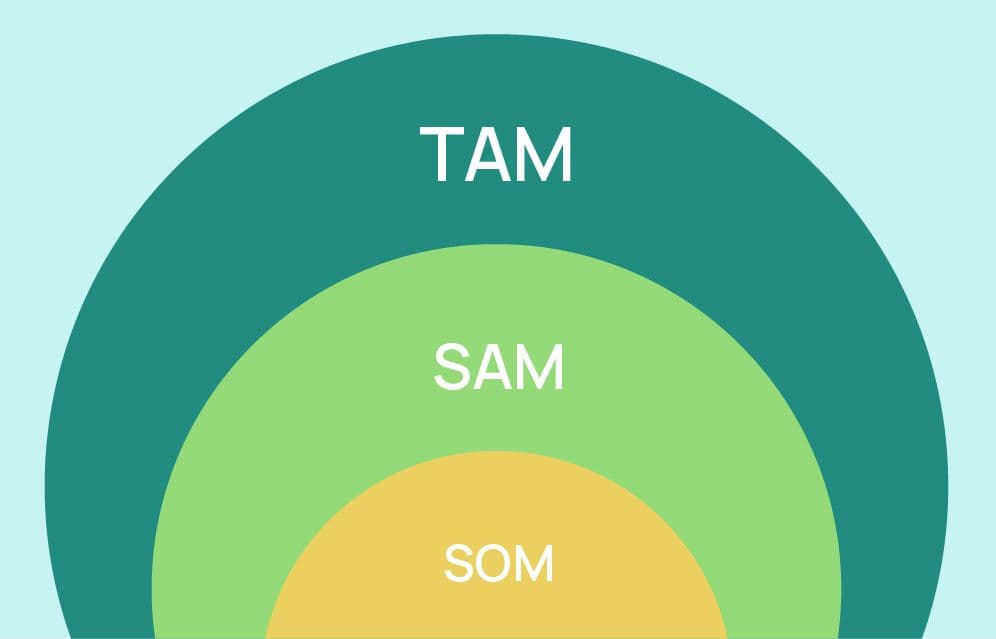- Blog /
- lead-generation-strategies
TAM, SAM, and SOM: The Essential Guide to Market Sizing and Targeting
27 Feb 2023
By AroundDeal

Welcome to this post where we’ll be discussing TAM, SAM, and SOM. These three acronyms are commonly used in business and marketing to understand the potential market size and growth opportunities for a product or service.
While they may sound technical, we’ll break them down into easy-to-understand concepts that you can apply to your own business or entrepreneurial pursuits. So, whether you're a seasoned marketer or just starting out, let’s dive in and explore TAM, SAM, and SOM together!
The Definition of TAM, SAM, and SOM
TAM (Total Addressable Market): This is the total market demand for a product or service, assuming there are no limitations or competition. It represents the maximum revenue potential for a business in a given market.
SAM (Serviceable Available Market): This is the portion of the TAM that a business can realistically target and serve, given its resources and capabilities. It represents the actual revenue potential for a business in a given market.
SOM (Serviceable Obtainable Market): This is the portion of the SAM that a business can realistically capture, given its marketing and sales efforts. It represents the achievable revenue potential for a business in a given market.
The Relationship among TAM, SAM, and SOM
At a word, TAM is the biggest picture, while SAM and SOM are progressively smaller slices of that picture that are more relevant to a particular business. Let’s see one example which may help you understand them much more easily.
You’re planning to launch a new mobile app that offers personalized meal plans based on users’ dietary preferences and goals. The TAM for this product could be all smartphone users who are interested in healthy eating, regardless of their location, age, or income. However, you may not be able to serve this entire market due to limitations such as language barriers or lack of awareness of your product.
The SAM for your product would be a subset of the TAM that you can realistically target and serve. For example, you may narrow down your target audience to English-speaking smartphone users in the United States who are interested in plant-based diets.
Finally, your SOM would be the portion of the SAM that you can realistically capture with your marketing and sales efforts. Let's say you estimate that 10% of your SAM would be interested in trying your app, and that you can convert 50% of those users into paying customers. In this case, your SOM would be 5% of the TAM for your product, which represents your achievable revenue potential in the market.
Three Important Reasons for Knowing TAM, SAM, and SOM
Resource Allocation: Understanding the size and potential of the market can help businesses allocate resources more effectively. Businesses can determine the optimal level of investment in areas such as research and development, marketing, and sales.
Targeted Marketing: By identifying the SAM and SOM, businesses can more effectively target their marketing efforts towards the most promising segments of the market. This can help to optimize marketing spend and improve the ROI (Return on Investment) of marketing campaigns.
Growth Opportunities: By analyzing the TAM, businesses can identify potential growth opportunities and expand their reach to new markets. By analyzing the SAM and SOM, businesses can identify areas of untapped potential and focus on growing their market share within their current market.
The Formulas of Calculating TAM, SAM, and SOM
TAM = (Total Number of Potential Customers) × (Average Revenue per Customer)
SAM = (Total Number of Potential Customers) × (Percentage of Customers the Business Can Realistically Serve)
SOM = (Total Number of Potential Customers in SAM) × (Percentage of SAM the Business Can Realistically Capture)
Using AroundDeal to calculate TAM, SAM, and SOM Efficiently
We are a B2B contact and intelligence platform that enables sales and marketing teams to obtain precise and current data easily, making the calculation of TAM, SAM, and SOM more efficient.
AroundDeal allows sales and marketing teams to accurately segment their target market and track their outcomes in real-time by providing access to a 110 million comprehensive database of contacts and companies.
In addition to providing comprehensive information about contacts and companies, AroundDeal also offers access to web-based profiles and job titles that facilitate the identification of crucial players such as decision-makers and budget holders in the purchasing process.
Through the use of enriched contact intelligence and analytics, AroundDeal empowers teams to gain a deeper understanding of their target audiences by accurately identifying who is making buying decisions and who has spending power. This capability enables teams to calculate TAM, SAM, and SOM more accurately.
The advanced search and filtering functions of AroundDeal make it easy for teams to focus on their target market, resulting in more precise and efficient calculations of TAM, SAM, and SOM.
Furthermore, sales and marketing teams can leverage the analytics provided by AroundDeal to formulate effective sales and marketing strategies. By comprehending the customer journey, gauging the influence of their campaigns, and assessing the effectiveness of their outreach initiatives, teams gain data-driven insights that enable them to optimize their TAM, SAM, and SOM calculations.
In Addition to TAM, SAM, and SOM
Undoubtedly, calculating total market demand and revenue projections plays a significant role in assessing business opportunities. However, in the B2B industry, closing sales is equally critical for business growth.
AroundDeal provides solutions to this challenge. By offering data-driven insights such as customer intelligence, account scoring, and segmentation, it assists in identifying the best target accounts, determining decision-makers like CEOs, monitoring conversations, and analyzing them to comprehend the context behind what buyers are communicating. Additionally, AroundDeal aids in tracking progress against the target market to ensure the right people receive the appropriate message.
By using predictive analytics tools to anticipate customer behavior and future market demand, businesses can create more effective marketing strategies.
Look no further! Start your journey with AroundDeal here!

%20(23).png&w=3840&q=75)
%20(9).png&w=3840&q=75)
%20(8).png&w=3840&q=75)
%20(5).png&w=3840&q=75)
%20(4).png&w=3840&q=75)